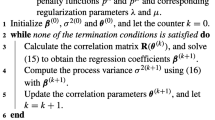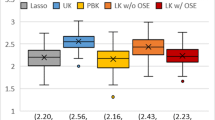Abstract
Kriging is a popular surrogate for approximating computationally expensive computer experiments. When sample points are limited, it is difficult to identify the overall trend of the problem at hand properly. Thanks to the interpolating characteristic of the Kriging model, a constant is widely used as the trend function, which neglects the overall trend presented by data. However, previous researches prove that an appropriate trend function considering high-order terms is able to enhance the approximation ability of the Kriging model. In this paper, a regularization approach is proposed to construct the trend function in the Kriging model to improve the prediction accuracy. First, a new weighting scheme, which is formulated as an optimization problem with regularization terms, is used to solve the regression coefficients. Then, the other model parameters are estimated by maximizing the likelihood function, which leads to a nested optimization problem. It is solved iteratively to obtain the final estimation of the model parameters. From a Bayesian point of view, the proposed regularization method can adaptively tune the parameter of the prior distribution on the regression coefficients in the iterative algorithm. To select good regularization parameters, a cross-validation method is used. The implementation is tested on several analytical examples and physical examples, and the experimental results confirm the effectiveness of the proposed approach.









Similar content being viewed by others
References
Acar E (2013) Effects of the correlation model, the trend model, and the number of training points on the accuracy of kriging metamodels. Expert Syst 30(5):418–428
Acar E (2014) Simultaneous optimization of shape parameters and weight factors in ensemble of radial basis functions. Struct Multidiscip Optim 49(6):969–978
Aute V, Saleh K, Abdelaziz O, Azarm S, Radermacher R (2013) Cross-validation based single response adaptive design of experiments for Kriging metamodeling of deterministic computer simulations. Struct Multidiscip Optim 48(3):581–605
Balabanov VO, Weckner O, Wu J (2014) Reducing error of polynomial approximation outside of designated design space for practical problems. In: 15th AIAA/ISSMO multidisciplinary analysis and optimization conference, p 2303
Ben-Ari EN, Steinberg DM (2007) Modeling data from computer experiments: sn empirical comparison of Kriging with mars and projection pursuit regression. Qual Eng 19(4):327–338
Bouhlel MA, Bartoli N, Otsmane A, Morlier J (2016) Improving kriging surrogates of high-dimensional design models by partial least squares dimension reduction. Struct Multidiscip Optim 53(5):935–952
Clark LD, Bae H, Gobal K, Penmetsa RC (2016) Engineering design exploration using locally optimized covariance Kriging. AIAA J 54(10):3160–3175
Clarke SM, Griebsch JH, Simpson TW (2005) Analysis of support vector regression for approximation of complex engineering analyses. J Mech Des 127(6):1077–1087
Dette H, Pepelyshev A (2010) Generalized latin hypercube design for computer experiments. Technometrics 52(4):421–429
Echard B, Gayton N, Lemaire M (2011) Ak-mcs: an active learning reliability method combining Kriging and monte carlo simulation. Struct Saf 33(2):145–154
Forrester AIJ, Keane AJ (2009) Recent advances in surrogate-based optimization. Progress Aerosp Sci 45(1):50–79
Forrester AIJ, Sóbester A, Keane AJ (2008) Engineering design via surrogate modelling: a practical guide. Wiley
Friedman JH (1991) Multivariate adaptive regression splines. Ann Statist 19(1):1–67
Galatsanos NP, Katsaggelos AK (1992) Methods for choosing the regularization parameter and estimating the noise variance in image restoration and their relation. IEEE Trans Image Process 1(3):322–336
Ginsbourger D, Dupuy D, Badea A, Carraro L, Roustant O (2010) A note on the choice and the estimation of Kriging models for the analysis of computer experiments. Appl Stoch Model Bus Ind 25(2):115–131
Goel T, Hafkta RT, Shyy W (2009) Comparing error estimation measures for polynomial and Kriging approximation of noise-free functions. Struct Multidiscip Optim 38(5):429–442
Golub GH, Heath M, Wahba G (1979) Generalized cross-validation as a method for choosing a good ridge parameter. Technometrics 21(2):215–223
Hoerl AE, Kennard RW (1970) Ridge regression: biased estimation for nonorthogonal problems. Technometrics 12(1):55–67
Hung Y (2011) Penalized blind Kriging in computer experiments. Stat Sin 21(3):1171–1190
Joseph VR, Hung Y, Sudjianto A (2008) Blind Kriging: a new method for developing metamodels. J Mech Des 130(3):1–8
Kersaudy P, Sudret B, Varsier N, Picon O, Wiart J (2015) A new surrogate modeling technique combining Kriging and polynomial chaos expansions–application to uncertainty analysis in computational dosimetry. J Comput Phys 286:103–117
Kwon H, Choi S (2015) A trended kriging model with r2 indicator and application to design optimization. Aerosp Sci Technol 43:111–125
Lee H, Lee DJ, Kwon H (2018) Development of an optimized trend Kriging model using regression analysis and selection process for optimal subset of basis functions. Aerosp Sci Technol 77:273–285
Li R, Sudjianto A (2005) Analysis of computer experiments using penalized likelihood in gaussian Kriging models. Technometrics 47(2):111–120
Liang H, Zhu M (2013) Comment on “metamodeling method using dynamic Kriging for design optimization”. AIAA J 51(12):2988–2989
Liang H, Zhu M, Wu Z (2014) Using cross-validation to design trend function in Kriging surrogate modeling. AIAA J 52(10):2313–2327
Liu H, Ong YS, Cai J (2018) A survey of adaptive sampling for global metamodeling in support of simulation-based complex engineering design. Struct Multidiscip Optim 57(1):393–416
Lophaven SN, Nielsen HB, Søndergaard J (2002) Dace–a matlab kriging toolbox–version 2.0. Tech. rep
Martin JD, Simpson TW (2005) Use of kriging models to approximate deterministic computer models. AIAA J 43(4):853–863
McIlhagga W (2016) Penalized: a matlab toolbox for fitting generalized linear models with penalties. J Statist Softw 72(6):1–21
Mehmani A, Chowdhury S, Messac A (2015) Predictive quantification of surrogate model fidelity based on modal variations with sample density. Struct Multidiscip Optim 52(2):353–373
Park MY, Hastie T (2007) L1-regularization path algorithm for generalized linear models. J R Stat Soc 69(4):659–677
Parmar M, Haselbacher A, Balachandar S (2010) Improved drag correlation for spheres and application to shock-tube experiments. AIAA J 48(6):1273–1277
Sacks J, Welch WJ, Mitchell TJ, Wynn HP (1989) Design and analysis of computer experiments. Stat Sci 4(4):409–423
Schobi R, Sudret B, Wiart J (2015) Polynomial-chaos-based Kriging. Int J Uncertain Quantif 5(2):171–193
Sóbester A, Forrester AI, Toal DJ, Tresidder E, Tucker S (2014) Engineering design applications of surrogate-assisted optimization techniques. Optim Eng 15(1):243–265
Tibshirani R (1996) Regression shrinkage and selection via the lasso. J R Stat Soc 58(1):267–288
Viana FAC (2011) Surrogates toolbox user’s guide. Gainesville, FL, Version 3.0. https://sites.google.com/site/srgtstoolbox/
Viana FAC, Haftka RT, Steffen V (2009) Multiple surrogates: how cross-validation errors can help us to obtain the best predictor. Struct Multidiscip Optim 39(4):439–457
Viana FAC, Simpson TW, Balabanov V, Toropov V (2014) Metamodeling in multidisciplinary design optimization: how far have we really come? AIAA J 52(4):670–690
Wang GG, Shan S (2007) Review of metamodeling techniques in support of engineering design optimization. J Mech Des 129(4):370–380
Yao W, Chen X, Ouyang Q, Tooren MV (2012a) A surrogate based multistage-multilevel optimization procedure for multidisciplinary design optimization. Struct Multidiscip Optim 45(4):559– 574
Yao W, Chen X, Zhao Y, Tooren MV (2012b) Concurrent subspace width optimization method for rbf neural network modeling. IEEE Trans Neural Netw Learn Syst 23(2):247–259
Yao W, Chen X, Ouyang Q, Tooren MV (2013) A reliability-based multidisciplinary design optimization procedure based on combined probability and evidence theory. Struct Multidiscip Optim 48(2):339–354
Zhang S, Zhu P, Chen W, Arendt P (2013) Concurrent treatment of parametric uncertainty and metamodeling uncertainty in robust design. Struct Multidiscip Optim 47(1):63–76
Zhang Y, Kim NH, Park C, Haftka RT (2016) Function extrapolation of noisy data using converging lines. In: AIAA Modeling and simulation technologies conference, p 2144
Zhang Y, Park C, Kim NH, Haftka RT (2017) Function prediction at one inaccessible point using converging lines. J Mech Des 139(5):051,402
Zhao L, Choi K, Lee I (2011) Metamodeling method using dynamic Kriging for design optimization. AIAA J 49(9):2034–2046
Zhao L, Choi K, Lee I (2013) Reply by the authors to the comment by H. Liang and M. Zhu. AIAA J 51(12):2989–2990
Zou H (2006) The adaptive lasso and its oracle properties. J Am Stat Assoc 101:1418–1429
Zou H, Hastie T (2005) Regularization and variable selection via the elastic net. J R Stat Soc 67(2):301–320
Acknowledgements
We would like to thank four reviewers for thoughtful comments that lead to improvements in the manuscript.
Funding
This work is supported by the National Natural Science Foundation of China (No. 11725211 and 51675525).
Author information
Authors and Affiliations
Corresponding author
Additional information
Responsible Editor: Raphael Haftka
Publisher’s Note
Springer Nature remains neutral with regard to jurisdictional claims in published maps and institutional affiliations.
Appendix
Appendix
The codes can be downloaded from here: https://github.com/zhangyi413/PK.
Rights and permissions
About this article
Cite this article
Zhang, Y., Yao, W., Ye, S. et al. A regularization method for constructing trend function in Kriging model. Struct Multidisc Optim 59, 1221–1239 (2019). https://doi.org/10.1007/s00158-018-2127-8
Received:
Revised:
Accepted:
Published:
Issue Date:
DOI: https://doi.org/10.1007/s00158-018-2127-8




